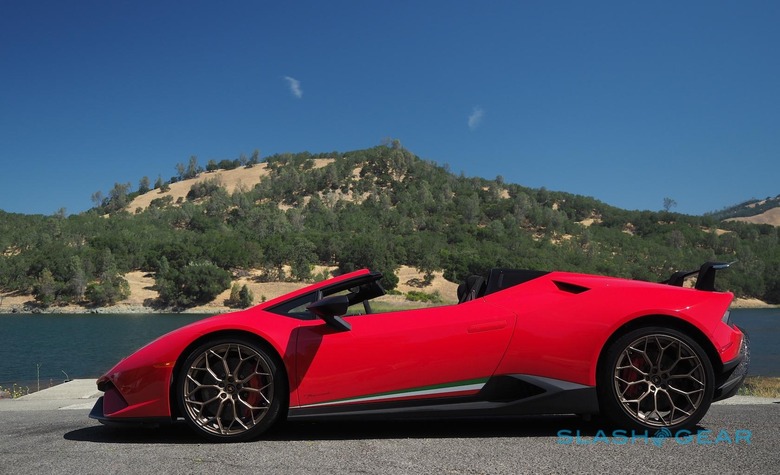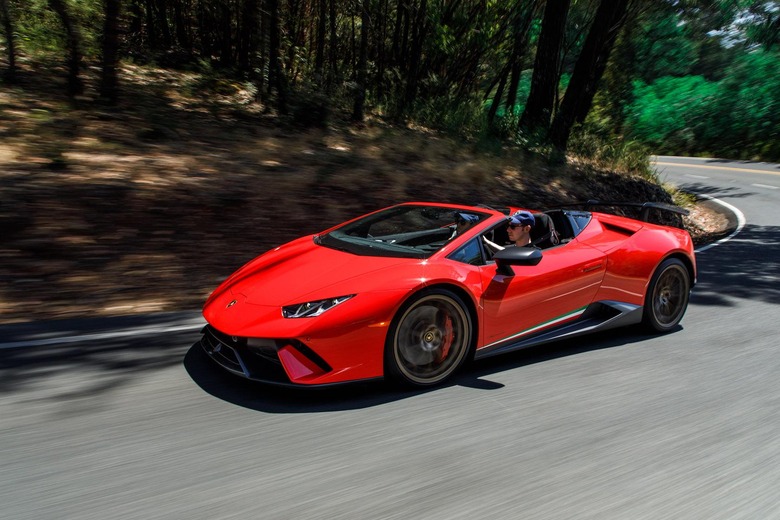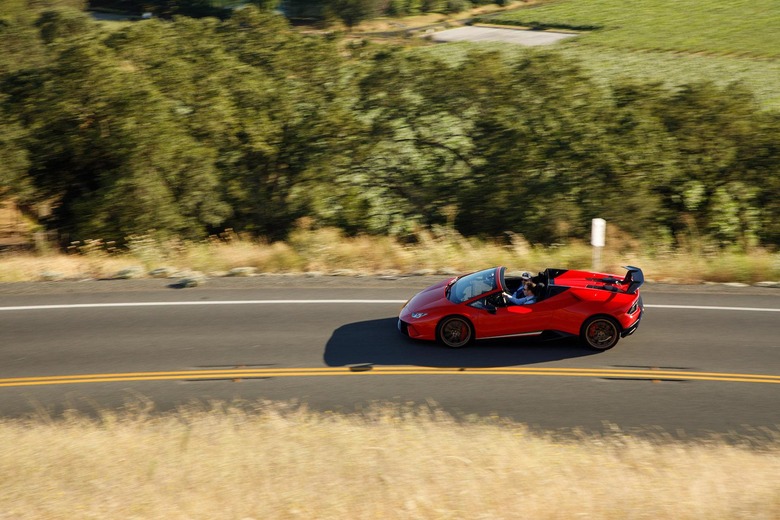2018 Lamborghini Huracan Performante Spyder first drive: Howling Corner King
There's an inevitable moment when you think you've screwed it up completely, when you're past that initial terror at being entrusted with the new Lamborghini Huracan Performante Spyder, and when the giddiness of a howling V10 engine and 640 horsepower is at its most beguiling. You were overly cautious at first, but that ebbed away as it took each turn you threw at it and shrugged them off with Mediterranean cool. Then the tricky corner comes.
It's tighter than you expected, with a sudden change in elevation, and as it coils blindly the lane narrows with the unyielding heft of rock to one side and the mystery possibility of opposing traffic appearing on the other. And you have just enough time to think your choice of expletive, as you turn the wheel some more and wince in preemptive horror at the sound aluminum and carbon fiber probably make when they're deforming in expensive, unforgivable ways.

Spoiler: the Performante Spyder didn't even screech a tire. No understeer, no oversteer. To my surprise, and delight, and the beginnings of a vaguely unhealthy addiction, the bright red convertible simply surged around the corner with a swan's grace, saving me from a hefty repair bill in the process.
That's a good thing. Lamborghini does not make cheap cars, but even by that measure the Performante Spyder is expensive. A regular Huracan Spyder comes in at $262k; the Huracan Performante Coupe starts at $274k. For this convertible version of the latter, figure on spending $308,859 plus $2,500 destination, and that's before you get to the options list.

Nonetheless, the automaker expects demand to be strong. The Huracan coupe/convertible sales split is roughly 50/50 in the US, and there will be fewer than 300 of this most capable of drop-tops coming to the country each year.
Gone is the roof, replaced with a fold of canvas that origamis open in 17 seconds and can be operated at speeds up to 30 mph. The rear window powers down, too, though visibility through the narrow gap – and interrupted by the broad wing – is never expansive. Better, then, to think of it as removing another potential baffle between your ears and the astonishing sound from the naturally-aspirated engine. You get a reversing camera but, were repairs to the 20-inch forged alloy wheels coming out of my pocket, I'd gladly sacrifice whatever extra weight a full 360-degree camera system would demand, just to avoid tears at parking.

The Spyder tips the scales at around 276 pounds more than the coupe, and you inevitably trade some rigidity when you lose the hard roof. Top speed from the 5.2-liter V10 is still 202 mph, though, and front to rear weight distribution remains 43:57. Considering the compromises typically inherent in going from coupe to convertible, the fact that the Huracan Performante Spyder gives up so little is admirable. I suspect you'd need to drive them back-to-back to spot any differences in flex.
The sharply creased, wedge-like looks that Lamborghini finesses so well still look fresh and fierce. Inside, there's fully-digital instrumentation and a spray of buttons down the sizable center console. A tiny, secondary screen in the middle shows supplementary gages and little else; if you want navigation instructions they'll have to share space on the primary display in front of the driver, as does multimedia. With no indicator stalk to get in the way of the lengthy paddle-shifters, you signal your intent to cowed other motorists with a little thumb-switch on the wheel.

Alcantara wraps the seats, the steering wheel, the dashboard, and the doors. Lamborghini offers plenty of contrast stitching options along with a hexagonal perforation design that laces a little extra color through what could otherwise be a fairly intimidating cabin. A bright red guard flips up to give thumbing the starter button the right sense of melodrama; a chromed yoke clicks the transmission into reverse.
Like the coupe, the Huracan Performante Spyder makes ample use of Lamborghini's lightweighting material of the moment, forged carbon composites. By chopping up carbon fibers, the automaker can mix them in a matrix of resins and mold them – first with pressure, then cured at high temperatures – into far more complex shapes than carbon fiber alone could be used for, and with thinner walls.

Lamborghini uses it for the front spoiler, the rear wing, engine cover, and rear bumper, along with a number of internal components like the air vents and center console. In all, the automaker says, it saves as much as 77 pounds from the regular car. At the same time, there's 30 horsepower more than the usual Spyder, together with a new air intake system, new exhaust system with reduced back-pressure, and an optimized 7-speed dual-clutch transmission.
The real magic is in ALA, or Aerodinamica Lamborghini Attiva, even though it's deceptively simple. Unlike the torque vectoring systems that some supercars use, or fiendishly technical moving rear wings, the Huracan Performante Spyder relies on controlled airflow for its active aerodynamics. At the front, an electric flap on the spoiler can cut drag and downforce in the name of extra speed.

At the back, meanwhile, two electric flaps at the base of the rear wing struts open and close automatically. Open, they send air up through those struts and out through slots under the wing, leading to minimal drag for maximum pace. Closed, meanwhile, they add more drag, contributing to the Lamborghini's downforce.
It's not just in a straight line, though. Like its coupe sibling, the Huracan Performante Spyder also uses ALA for aero vectoring: during a turn, it opens just one of the two flaps and pushes air to the unloaded side of the car. That increases downforce to the inside wheels, for greater traction and a reduction in the steering angle needed.

At the same time, since the other flap is still closed, aero vectoring reduces drag and downforce from the loaded side. "It's a waste of energy" otherwise, Lamborghini USA boss Alessandro Farmeschi points out, comparing the process to steering a bobsled. ALA is all automatic, with the flaps opening and closing in half a second, and with minimal moving parts involved.
You can turn it off, but you'd be a fool to. "This is witchcraft" I marveled out loud more than once, pushing the Performante Spyder increasingly hard through the twisting switchback roads in the hills above Calistoga, California where the automaker had invited me out to test its latest treat. I don't normally talk to myself while driving, but the Lamborghini's ability to take a corner carrying – in theory – too much speed, but complete it with a perfect line and zero tire squeal is monstrously impressive.

What sets it apart from rival supercars is how natural it all feels. Traditional torque vectoring, which slows the inside wheels either by braking or through complicated mechanical gear-sets, can certainly deliver a great-handling car, but it can also feel artificial in action. Like the car is pivoting around you, the rear pushing out somehow as the electrical systems coax you through each turn.
ALA, in contrast, feels like you're driving a regular car, just one that has been fitted with the stickiest racing tires around. There's no sudden moment where the assistance kicks in, or a jarring sense that the car is stealing control from you as driver. You just snap the paddle to downshift, turn the wheel, and the Performante Spyder corners perfectly.
As with the coupe, there are three drive modes to choose between. Strada is the road-going mode, the soundtrack damped down to a seductive gurgle but the ride sufficiently soft and smooth to soak up road imperfections. Click the toggle down to Sport, and the engine and exhaust systems gain a more aggressive edge, while most of the horsepower is pushed to the rear wheels. If you want to whip the rump out, here's your mode.

Finally, there's Corsa. It's the Huracan Performante Spyder at its purest: everything done in the name of maximum speed and the best handling. You're wholly responsible for gear changes, too, but that's no hardship when the transmission snaps so hungrily between the ratios. The 8,500 rpm redline arrives with an eagerness that would be shocking, had the engine not been shrieking with a fury unchained all the way there.
In short, it's just as jaw-droppingly wowing as last year, when I drove the Huracan Performante Coupe on the track. Back then, I questioned whether the Lamborghini's incredible poise had resulted in a car so unshakable, the average driver could never get entertainingly close to the limits on public roads.
Turns out, I had it the wrong way around. The Performante – whether you're lucky enough to have it in Coupe or Spyder form – isn't cold in its competency: it just uses that to wrench as much fun from every drive as it possibly can. Overtaking, cornering, straight line speed, all are delivered with the giddied frenzy of a puppy on uppers.

The Spyder may be 0.2 seconds slower from 0 to 60 mph than its hard-topped sibling, but if you're complaining about 3.1 seconds and the extra auditory pleasure doing away with the roof delivers, there's something seriously wrong with you. Sure, the absence of auto-upshifts when you collide with the rev limiter in Corsa mode can still be jarring, but it's less of a headache on public roads compared to when you're trying to nail the perfect track time.
The Huracan Performante Spyder's overall success comes down to the interplay of two things. First, of course, its stupendous technical and engineering talent, but also its ability to seize your emotions in its mechanical fist and milk pure joy from them, like squeezing the glistening juice from a ripe Italian peach. Lamborghini has made that rarest of beasts in the already-rarified echelons of supercardom: a track star that's not only usable, but positively glee-filled, on regular roads.
